Name
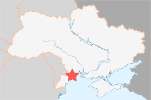
| ||
| Odesa (Odessa) |
Одеса (Odesa) is the Ukrainian name - and not very different to the Russian name, which is Одесса (Odessa). Both names are well used today, though due to historic reasons, the version with double s might me a little bit more common outside the Ukraine. The present name was assigned in 1794 by the Russians - before, a small settlement with the Turkish name Khadjibey occupied the site.
Location
Odesa lies in the southwest of the Ukraine at the Black Sea coast. It's the center of the large district Odessa Oblast, which stretches along the Black Sea all the way to →Romania. The border to →Moldova is only a few dozen kilometers away.
Population
Very recently, Odesa crossed the 1 million people barrier - as of 2007, it had 1,001,000 inhabitants.
History
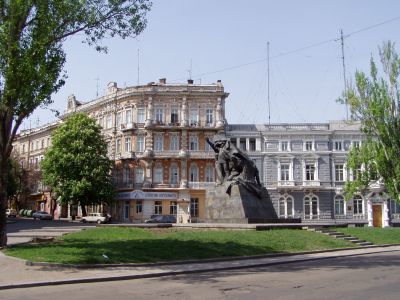
| ||
| Along Primorski avenue: Art noveau en masse |
Odessa is a very old town, probably founded by ancient Greeks. However, the town as it exists today was founded in 1794, initiated by Catherine the Great. She wanted to establish a new Russian gateway to the Black Sea and the Mediterranean Sea. It worked out well. Present-day Odessa has more than one million inhabitants and houses one of the most important harbors of the Ukraine. The old city centre doesn't look like a city of over a million inhabitants. It's only possible to grasp the real size of town when leaving the town eastwards. At the main train station, the slogan City of Heroes welcomes the visitor. Historically, this is not even an exaggeration: a large-scale uprising in 1905 (see Potemkin steps) and strong partisan activity during the German occupation justify the title. Consequently, Odessa was heavily damaged. Partisans mostly operated from an extensive tunnel system called katakombi, which is all in all around 1,000 km long (!) and criss-crosses the underground of the city and the outskirts. A part of it is used as a museum on partisan activity, but it's far away from the city centre.
Orientation
The older part of the town starts right in front of the main train station and stretches north-east all the way to the harbour, which is around 3 km away. Don't expect a nice view over the Black Sea or something - the coastline around Odessa is heavily industrialised or part of the harbour. But there's a nice beach and popular holiday resort around Arkadija 8 km south of the city.

| ||
| Buildings in the old town are quite colourful |
The town is very rich - this is at least the first impression one will get in the city centre. Many expensive boutiques and restaurants concentrate in downtown Odessa - among them at least three Sushi bars with prices not lower than in London or somewhere else. This comes as no surprise - Odessa has an important port and is the Ukrainian gateway to the rest of the world. Nevertheless, there are only very few Westerners making their way to Odessa. A camera team interviewing visitors wanted to interview us in the streets, but when I told them that my Russian isn't very good they ran away. Looks like they didn't expect a Western traveller. What a pity - I would even have answered their questions, because I wouldn't have seen the result on T.V. and therefore didn't care.
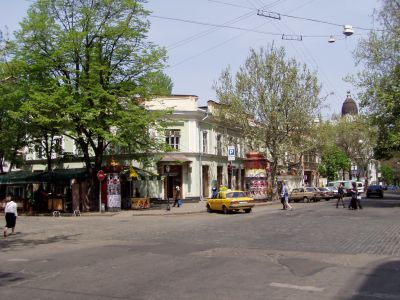
| ||
| In the centre of Odessa - small houses, nice architecture,
lots of green - this place is wort a longer stay! |
Odessa has its own attractions and interesting places - see information below - but even without them it would be interesting enough to stay for a while. Most of the city centre is laid out on a grid pattern. Almost all buildings seem to have been built around the same time. Except for a few churches, there are no tall buildings in town, which makes it a charming place. Additionally there are countless trees lining up along the streets. A beautiful example for this scenery is Primorski Alley above the Potemkin steps. The diversity of colours is quite impressive as well. Next to a lime-green house stands a madder-red house, followed by a pale purple building and a bright yellow one. Adding the green of the trees lining up along the roads, it offers an interesting combination. Most buildings are in a good condition. However, the closer you get to the train station, the newer but also shabbier it gets.
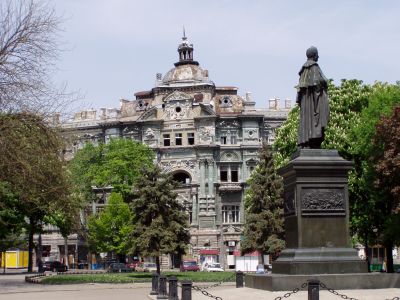
| ||
| Unfortunately, this incredible building is threatened with
complete dilapidation |
Getting there / transportation
In 2003, there was a direct train from Odesa to →Chisinau (Moldova), crossing the territory of →Transnistria (PMR) and its capital →Tiraspol first. In 2008, I couldn't find this train on the time tables any more, so this service might have been suspended.
Odesa offers some interesting national and international train connections. Trains to →Kyiv (Kiev) need around 10 hrs for the 600 km, a ticket in a compartment costs around € 7. There's one night train to →Simferopol on the Crimean Peninsula. This train needs 14 hrs for the 540 km - the cheapest ticket (no compartment, Plazkartnyi) costs € 4 only. There are also direct trains to →Dnepropetrovsk, →L'viv (L'vov) and even further to →Uzhhorod the latter running via L'viv.
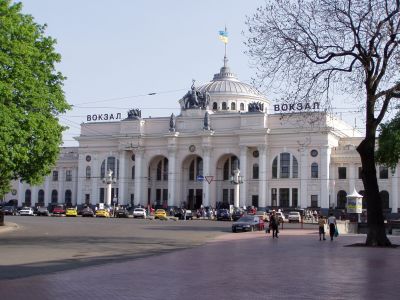
| ||
| The train station. As everywhere in the former Soviet Union, it looks almost like a palace |
There is also a daily train to →Minsk (Belarus) (22½ hrs) and another one to Moscow (24 hrs). Arrange visa beforehand!
Ismail - that's as far as you can get to the west. Note that there is no border crossing to Romania south of Moldova!. Talking about Moldova - the shortest way to Moldova is via the crossing at Pervomaisk, which leads straight into the renegade republic of →Transnistria (PMR). While it is possible to take this route, you should be warned that most people have to pay heavy bribes at the border. In order to avoid this, you should either take the crossing straight into Moldova near Ismail (from there, busses run straight through →Comrat (Gagauzia) and further on to →Chisinau (Moldova). While this route is safer, it's also very time-consuming: The train from Odesa to Ismail needs 7 hours, and it's only departure per day.
Apparently there are no useful, regular ferry connections to →Romania, →Bulgaria etc. - not to mention →Georgia and the like. As of 2003 and subject to change - maybe.
Потёмкинська Лестница (Potemkinska Lestnitsa)
There are only very few buildings or structures owing their reputation to a movie in a way the Potemkin steps (actually it's Potëmkin, to be pronounced Potyomkin) in Odessa do. The steps themselves offer two interesting features. One is the fact that you can't see the steps at all when standing atop - all you can see are a few landings. However, when you stand below the steps, all you can see are steps. It's an optical illusion - the uppermost step is 12.5 m, the lowest 21.6 m wide. The difference is too small to notice when climbing the steps. but when you stand in front of the steps, it looks more gigantic and long than it really is. The steps were built within four years and completed in 1841.
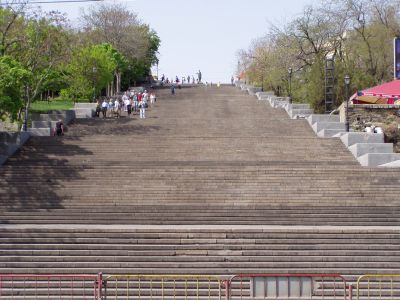
| ||
| Potemkin steps - with love from Eisenstein! |
It only got famous when it appeared in Sergey Eisenstein's silent film Battleship Potemkin (a good review on the movie can be found here: →SensesOfCinema.com). The movie was produced in 1925 and deals with an uprising in 1905, which started aboard the battleship Potemkin and eventually spreaded out over the town, involving innocent civilians. The uprising was brutally put down and a line of Cossacks moving down the steps mercilessly shooting everyone fleeing. Many injured and dead people left on the steps, a pram with a baby inside rolling down - the way Eisenstein juxtaposed round with rectangular shapes, humanity with cruelty, individuality with anonymity was unique and some kind of cineastic revolution. When standing in front of the Potemkin steps, one inevitably recalls scenes of Eisenstein's moving film.
But who was Potemkin anyway? He was the local ruler and nobleman of Odessa area at the end of the 18th century. Thanks to him, the term "Potemkin's villages" was created. It is said that he set up empty villages with beautiful façades to pretend a prospering countryside when his patroness Catherine the Great travelled the area. Nevertheless he seemed to be a popular and capable administrator who also managed to annex the →Crimea peninsula.
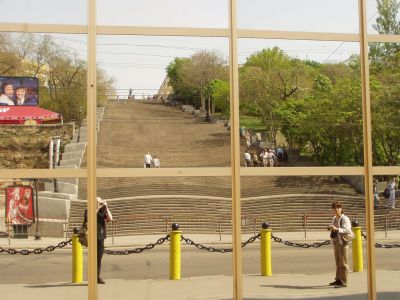
| ||
| The famous Potemkin steps (and tabibito and his wife) from a different point of view...with love from Eisenstein! |
Opposite the street below the steps there is a large pier with a new and expensive-looking hotel on it. From here, several ferries run to places around Odessa. There's a beautiful square above the steps with a monument in the middle. The monument is dedicated to Emmanuel Richelieu, a French nobleman, who fled from revolution in his country in 1789 and ended up in Russia. He managed to make himself useful at the Russian court and was finally appointed to the post of governor of Odessa in 1803. Due to a lack of inhabitants, he invited many Germans to settle in and around Odessa. For some reason, the monument shows Richelieu wearing a Roman toga.
Академічний Театр Опери???та???Балету
(Akademichnii Teatr Opery ta Baletu)
The opera house of Odessa is beautiful from the inside and from the outside. And it's very famous. Many people consider it as one of the most amazing operas in the world. The building itself was designed by a Viennese architect and built at the end of the 19th century. It combines baroque and renaissance elements and corresponds well with other buildings around the opera. Above the entrance, large statues of the Muses for music, dance, comedy and drama welcome the visitor. But who's performing inside? All the notables. And the ticket prices are more than reasonable. Unfortunately, we ourselves didn't have the chance to watch a play, since we arrived late in the evening and had to leave the next evening. But I'm sure that a visit is very rewarding. It should be mentioned that the music and theater scene in Russia, the Ukraine and other countries of the Soviet Union is highly developed and trying hard to survive economically hard times.
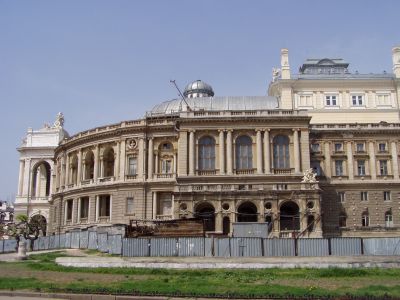
| ||
| The opera of Odessa |
вул. Дерібасівська (vul Deribasivska)
Before or after going to the theatre - or even without - it's always a good idea to finish the evening somewhere at Deribasivska boulevard in the centre of town. Everyone owning some money is going to spend it in one of the luxurious boutiques and restaurants along Deribasivska. It's the place to go to see what's hip in the Ukraine and in Russia. A wide part of the street has been turned into a pedestrian zone. Although much cheaper than in Western Europe, prices in restaurants and cafés are incredibly high by Ukrainian standards. It's easy to spend around € 20 for a dinner for two persons. But that's just fair - the quality is better than average, too.
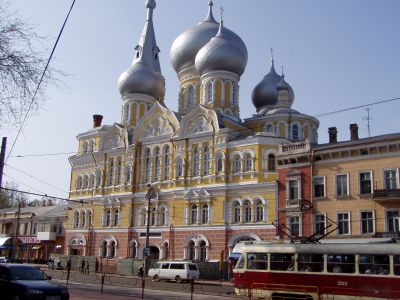
| ||
| The church opposite the train station: Aren't the domes a little bit too big!? |
It didn't take long to find a hotel in the centre. We ended up at Hotel Zentralnyi, although it didn't really look like it would fit our budget. And they told us that there's only a suite left. But the price was as surprising as the suite itself: 130 UAH (€ 22) for a very, very spacious suite was more than a good bargain. Here's the address:
Vul. Preobrashenska 40
Tel.:(0482)-268406
Location: Right in the middle of the town, near Deribassivska rd.
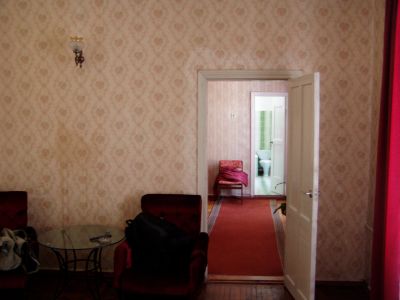
| ||
| Suite in the Hotel Zentralnyi, Odessa |
- www.odessa.ua/ Official website of Odessa - quite useful and with an English version.
Do you have or do you know a good website about Odesa? Don't hesitate, let me know! After checking it, I would love to add it to the link list. You can submit a link by using the →contact form. Note that commercial websites will be treated differently.
©2024 Europe-East.com

 Albania
Albania Ukraine
Ukraine